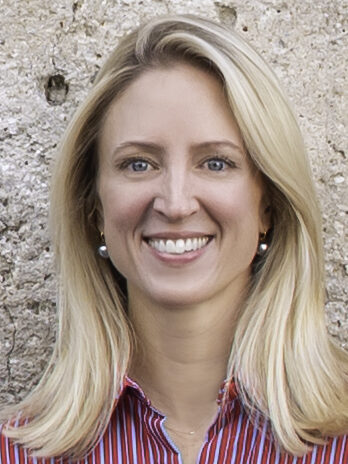
What inspired you to write this book?
DWIGHT MCINVAILL: I grew up in an art gallery — my childhood home, that is, near the strand at Myrtle Beach, South Carolina, when it was still somewhat of a village with high sand dunes and an easy view of the ocean, marshes, pines, and ever-changing expanse of a Southern sky. The natural beauty of the locale was abundant, and it was echoed in the vibrant, evocative watercolors that hung everywhere in our house. From my earliest years, I knew that the creator of these paintings was an extraordinary person. And when I later found and read the hundreds of letters that Alice Ravenel Huger Smith had written to my parents, I was completely and utterly dazzled. How could I not share this wonderful person with others?
ANNE TINKER: I wanted to honor Alice who was an extraordinary woman and artist. And my great-aunt. My family spent two weeks every spring at 69 Church Street, so I knew her for the first eleven years of my life. I remember sitting on the joggling board with her on the piazza and sometimes peeking at her sketching in the garden behind the house wearing a wide-brimmed hat. Many of her watercolors adorned the walls of our house.
CAROLINE PALMER: I’ve always been in awe of my great-great-aunt Alice and named my youngest daughter after her. Growing up, I marveled at her paintings and developed an early interest in art. That interest led me to major in art history in college and work for several years at an art museum early in my career, and I still love to paint in my spare time. So co-authoring this tribute to Alice is meaningful, and it came at just the right time. I had recently moved to Charleston from New York and left my corporate job, so I was ready for a project — especially one that connected my family, new hometown, and interest in art. I’ve relished the opportunity to meet experts on Alice, familiarize myself with her work at institutions like the Gibbes Museum of Art, and learn about Charleston’s complicated history.
Tell us about the collaboration process.
DWIGHT: My parents, Harry and Talulah McInvaill, were dear friends of Alice. And to us children, she and her sister Caroline were like two extra grandmothers. And so, of course, we knew the loved ones of her family, too. By my mid-twenties (four decades ago) I was serious about writing a book on her artistic life, but I was persuaded by Alice’s nieces and nephew to wait until I was older. Then life intervened and contacts lessened. But when I came around to writing the book again in my mid-fifties, it was delightful to begin a collaborative process that involved Alice’s family members, particularly her great-niece Anne and her great-great-niece Caroline. Collaborating with these two women was terrific as they spurred me on to do better and helped me to tame and trim the manuscript. They also brought a different perspective to some key aspects and located so many additional images. The readers of Alice should be as grateful as I for their fine scholarship and attention to detail which improved the final work substantially.
ANNE: Dwight began sending me drafts of a manuscript about Alice, based on his extensive research, several years ago. In the spring of 2019, during one of his visits to our house, he asked my daughter Caroline and me to join him and add our family’s knowledge about and perspective on Alice, edit the manuscript, and take the book forward to publication.
CAROLINE: Collaborating on this book has been rewarding. By bringing the McInvaill and Smith family collections, archives, and talents together, we believe we have produced a personal and comprehensive view of Alice’s life and career. We’ve also had many discussions about how to portray a historical figure who, born into a prominent family of rice planters, held outdated values and nostalgic views of history and lived in the segregated South. We’ve had thought-provoking conversations about the Charleston Renaissance in light of today’s efforts to tell a more inclusive story of the past. Striking a balance hasn’t been easy: we’ve tried to acknowledge the injustices of that era while focusing primarily on Alice’s experiences and accomplishments.
View/Download the Full Author Q&A Below
About the Authors

Dwight McInvaill directs the Georgetown County Library. His focus on innovation as a public librarian in South Carolina has been recognized by The New York Times and Carnegie Corporation. He was a member of the steering committee to found the Digital Public Library of America and served on the board of the Lowcountry Rice Culture Project. He has a master’s degree in library science from the University of North Carolina at Chapel Hill, and has given many lectures on Alice Smith, a mentor and friend to his parents.

Caroline Palmer is a communications, marketing, and human resources professional. A great-great-niece of Alice Smith, she has a BA in art history from Duke University and an MBA from Columbia Business School. She is a trustee of Middleton Place Foundation and lives with her husband and two daughters in Charleston, South Carolina.

Anne Gaud Tinker is a retired international public health specialist. A great-niece of Alice Smith, she has graduate degrees from Georgetown and Johns Hopkins Universities. She is a trustee of Middleton Place Foundation, on the board of the Gibbes Museum of Art, and a member of the Historic Charleston Foundation’s National Advisory Council. She and her husband divide their time between South Carolina and Massachusetts.